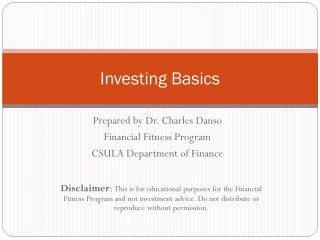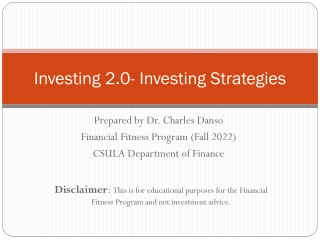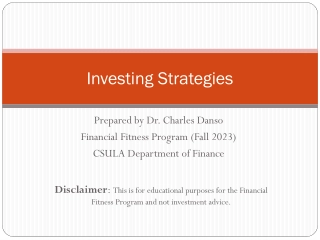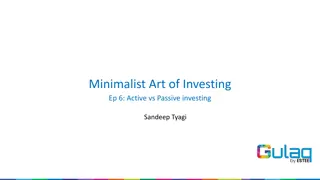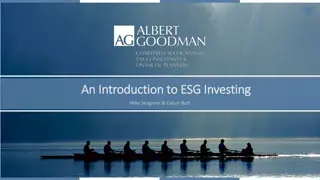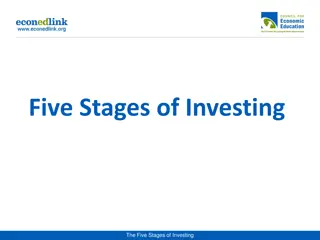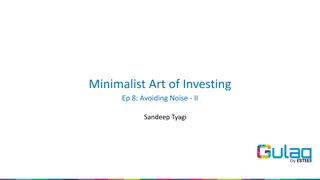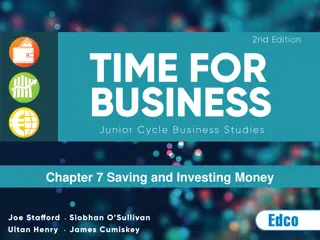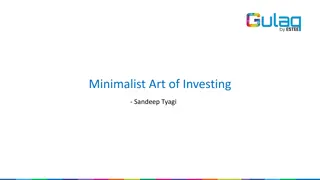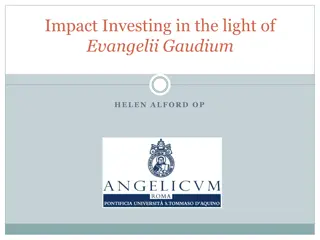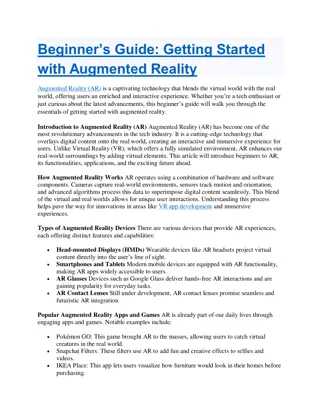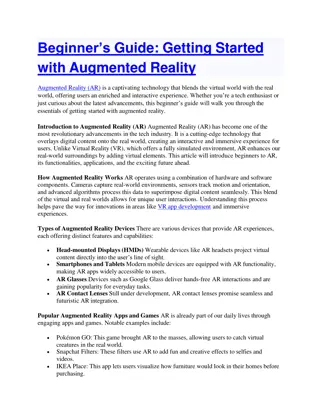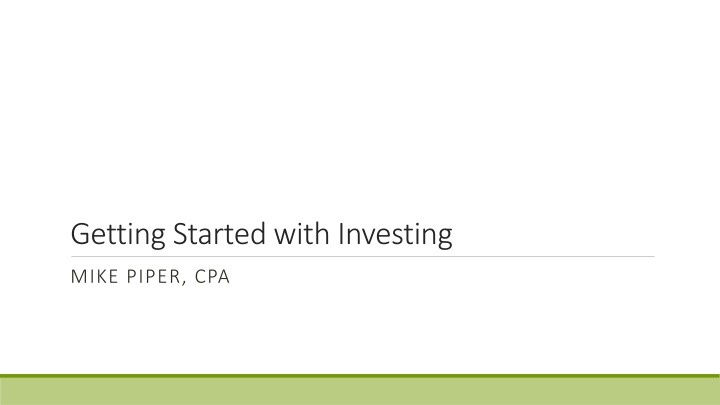
Investing Essentials: Building Blocks of Stocks, Bonds, and Mutual Funds
Explore the fundamental concepts of investing with stocks, bonds, and mutual funds. Learn about asset classes, portfolio construction, and risk management for a successful investment journey.
Download Presentation

Please find below an Image/Link to download the presentation.
The content on the website is provided AS IS for your information and personal use only. It may not be sold, licensed, or shared on other websites without obtaining consent from the author. If you encounter any issues during the download, it is possible that the publisher has removed the file from their server.
You are allowed to download the files provided on this website for personal or commercial use, subject to the condition that they are used lawfully. All files are the property of their respective owners.
The content on the website is provided AS IS for your information and personal use only. It may not be sold, licensed, or shared on other websites without obtaining consent from the author.
E N D
Presentation Transcript
Getting Started with Investing MIKE PIPER, CPA
Getting Started with Investing Getting Started with Investing 1. The building blocks (asset classes, types of accounts) 2. Constructing a portfolio 3. Staying out of trouble
Getting Started with Investing Getting Started with Investing 1. The building blocks (asset classes, types of accounts) 2. Constructing a portfolio 3. Staying out of trouble
The Building Blocks The Building Blocks Stocks A stock is a share of ownership of a business. Make money through dividends (distribution of profits) and through price appreciation. Sometimes referred to as equities.
The Building Blocks The Building Blocks Bonds Loan to a borrower (government or business). Make money via interest paid by the borrower. In the category known as fixed-income.
The Building Blocks The Building Blocks Mutual Funds Pool of money, run by a fund manager. Own a collection of other investments (stocks, bonds, or both). Can be actively managed or passively managed.
The Building Blocks The Building Blocks Actively Managed Mutual Funds Fund manager tries to pick investments that will have above-average performance.
The Building Blocks The Building Blocks Passively Managed Mutual Funds Fund simply tries to track the performance of a given index (e.g., S&P 500, which reflects the performance of 500 large companies in the US). A common use for passive funds is to track the total US stock market or total international stock market. Index funds and exchange-traded funds (ETFs) are the most common types of passively managed funds.
Risk and Reward Risk and Reward With a bond, the borrower promises to pay you a certain amount of interest each year, and they promise to repay principal at maturity. With stocks, there are no guarantees. You simply expect (hope) to get returns. Because stocks have uncertain returns, they also have higher expected returns. (People wouldn t buy shares in companies unless they thought they d earn more than they would via bonds.)
Types of Accounts Types of Accounts Taxable accounts Traditional IRA ( individual retirement account ) Roth IRA 401(k), 403(b) Roth 401(k), Roth 403(b)
Taxable Accounts Taxable Accounts Interest is taxable. Dividends are taxable, but at a reduced rate. Short-term capital gains (from selling an asset held for 1 year or less) are taxable as ordinary income. Long-term capital gains (from selling an asset held for longer than 1 year) are taxable at a reduced rate.
Traditional IRAs Traditional IRAs Can contribute up to lesser of earned income or $6,000 per year ($7,000 if age 50+). Contribution is deductible. However, if you have a workplace retirement plan, depending on income level you may not get a deduction. No tax on growth while money stays in the account. Withdrawals ( distributions ) are taxable as income. 10% penalty for early distributions (pre-59.5)
Roth IRA Roth IRA Contribution limit shared with traditional IRA. ($6,000 for 2021) No deduction for contribution. Account grows tax-free. Distributions of earnings are tax-free if taken out after age 59.5 and you have had a Roth IRA for 5 years. (10% penalty if early) Contributions can come back out, at any time tax-free, penalty-free. Ability to contribute phases out based on MAGI: $125,000 - $140,000 for singles and heads of household $198,000 - $208,000 if married filing jointly
401(k) Plans 401(k) Plans Akin to a traditional IRA through your employer. (Deductible contributions, account grows tax-free, taxable distributions.) $19,500 contribution limit ($26,000 if age 50+). Some employers offer a matching contribution. 403(b) plans are very similar.
Roth 401(k) or Roth 403(b) Roth 401(k) or Roth 403(b) Contribution limit shared with traditional 401(k) or 403(b) ($19,500 for 2021). No deduction for contribution. Account grows tax-free. Distributions are tax-free if you are at least age 59.5 and your first Roth contribution to the plan was at least 5 years ago.
Constructing a Portfolio Constructing a Portfolio 1. Individual stocks/bonds or mutual funds? 2. Actively managed funds or passively managed funds? 3. What asset allocation to use? (How much in stocks and how much in bonds?)
Constructing a Portfolio Constructing a Portfolio 1. Individual stocks/bonds or mutual funds? 2. Actively managed funds or passively managed funds? 3. What asset allocation to use? (How much in stocks and how much in bonds?)
Constructing a Portfolio Constructing a Portfolio Don t bother picking individual stocks. Expectations for a company are already priced into the company s stock price. To pick above-average stocks, you don t just have to identify profitable companies. You have to identify companies that turn out to be more profitable than the market expected them to be.
Constructing a Portfolio Constructing a Portfolio When you pick stocks, you re competing against professional investors. When you use individual stocks, you increase your risk (less diversified) without increasing your expected return.
Constructing a Portfolio Constructing a Portfolio 1. Individual stocks/bonds or mutual funds? 2. Actively managed funds or passively managed funds? 3. What asset allocation to use? (How much in stocks and how much in bonds?)
Constructing a Portfolio Constructing a Portfolio Most actively managed funds perform worse than passively managed funds. Active fund success rate for the 20-year period ending 12/31/2020: 12.8% for US large-cap blend funds 16.8% for US large-cap value fund 11.3% for US large-cap growth funds 8.7% for US mid-cap blend funds 29.6% for US small-cap blend funds 14.6% for foreign large-cap blend funds 9.7% for intermediate-term core bond funds
Constructing a Portfolio Constructing a Portfolio The expense ratio is the most proven predictor of future fund returns. We find that it is a dependable predictor when we run the data. That's also what academics, fund companies, and, of course, Jack Bogle, find when they run the data. -Russel Kinnel of Morningstar
Constructing a Portfolio Constructing a Portfolio Using expense ratios to choose funds helped in every asset class and in every quintile from 2010 to 2015. For example, in U.S. equity funds, the cheapest quintile had a total-return success rate of 62% compared with 48% for the second-cheapest quintile, then 39% for the middle quintile, 30% for the second-priciest quintile, and 20% for the priciest quintile. So, the cheaper the quintile, the better your chances. -Russel Kinnel of Morningstar
Constructing a Portfolio Constructing a Portfolio Low-cost funds tend to outperform higher-cost funds. And index funds (or ETFs) are the most reliable options for low costs. But don t worry about very small differences (e.g., 0.05% vs. 0.07%). That will often change from one year to the next anyway.
Constructing a Portfolio Constructing a Portfolio Index Funds or ETFs? For most people, there are 100+ other financial planning decisions that are more important than this one. ETFs let you use orders other than market orders. And you can have trades executed during the day. And costs are ever-so-slightly lower (sometimes). Index funds let you place round-dollar-amount orders. Seriously, this is not important.
Constructing a Portfolio Constructing a Portfolio 1. Individual stocks or mutual funds? 2. Actively managed funds or passively managed funds? 3. What asset allocation to use? (How much in stocks and how much in bonds?)
Constructing a Portfolio Constructing a Portfolio The big asset allocation question: How much in stocks and how much in bonds? Your asset allocation should be based on your risk tolerance. Risk tolerance has two components: Economic: how much risk can you afford? Mental: how much risk can you psychologically tolerate?
Avg. Annual Return (1926 2019) 6.0% 7.1% 7.7% 8.1% 8.6% 9.0% 9.4% 9.7% 10.2% Worst Calendar Year -8.1% (1969) -10.1% (1931) -14.2% (1931) -18.4% (1931) -22.5% (1931) -26.6% (1931) -30.7% (1931) -34.9% (1931) -43.1% (1931) 100% bonds 80% bonds, 20% stocks 70% bonds, 30% stocks 60% bonds, 40% stocks 50% bonds, 50% stocks 40% bonds, 60% stocks 30% bonds, 70% stocks 20% bonds, 80% stocks 100% stocks
The Three The Three- -Fund Portfolio Fund Portfolio Total Stock Market Index Fund (or ETF) Total International Stock Index Fund (or ETF) Total Bond Market Index Fund (or ETF) Includes everything you need. (Super diversified.) Low-cost. Simple. (Easy to understand, easy to maintain.)
The Two The Two- -Fund Portfolio Fund Portfolio Vanguard Total World Stock Index Fund (or ETF) Total Bond Market Index Fund (or ETF)
Target Target- -Date Funds Date Funds General idea is that they start aggressive and become more conservative as the named retirement date approaches. Significant variation in underlying allocation from one fund company to another. Ignore the date in the name. Pick based on allocation.
Staying Out of Trouble Staying Out of Trouble Keep a long-term focus. You don t have to check your portfolio everyday or even every month. Watch out for recency bias. Just because the market has been going up doesn t mean it will keep going up. Ditto for down markets.
Staying Out of Trouble Staying Out of Trouble Automate your investing. Automating your retirement account contributions is the safest way to make sure you re actually saving and investing. Target-date funds automate rebalancing. The more you have automated, the less often you have to check your portfolio.
Staying Out of Trouble Staying Out of Trouble Ignore the financial news. The financial media s goal is just to get your attention. The flood of information about Tesla/Bitcoin is not there for any altruistic purpose. It s not because this is critical information for personal financial planning. It s just to get your attention.
Staying Out of Trouble Staying Out of Trouble There s no perfect portfolio. There is no perfect asset allocation, except in hindsight. There are plenty of good enough allocations. There is no best fund, except in hindsight. There are plenty of good enough funds.
Getting Started with Investing MIKE PIPER, CPA

